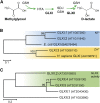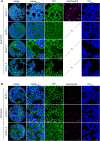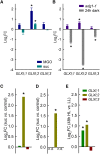Defense against Reactive Carbonyl Species Involves at Least Three Subcellular Compartments Where Individual Components of the System Respond to Cellular Sugar Status
- PMID: 29150548
- PMCID: PMC5757266
- DOI: 10.1105/tpc.17.00258
Defense against Reactive Carbonyl Species Involves at Least Three Subcellular Compartments Where Individual Components of the System Respond to Cellular Sugar Status
Abstract
Methylglyoxal (MGO) and glyoxal (GO) are toxic reactive carbonyl species generated as by-products of glycolysis. The pre-emption pathway for detoxification of these products, the glyoxalase (GLX) system, involves two consecutive reactions catalyzed by GLXI and GLXII. In Arabidopsis thaliana, the GLX system is encoded by three homologs of GLXI and three homologs of GLXII, from which several predicted GLXI and GLXII isoforms can be derived through alternative splicing. We identified the physiologically relevant splice forms using sequencing data and demonstrated that the resulting isoforms have different subcellular localizations. All three GLXI homologs are functional in vivo, as they complemented a yeast GLXI loss-of-function mutant. Efficient MGO and GO detoxification can be controlled by a switch in metal cofactor usage. MGO formation is closely connected to the flux through glycolysis and through the Calvin Benson cycle; accordingly, expression analysis indicated that GLXI is transcriptionally regulated by endogenous sugar levels. Analyses of Arabidopsis loss-of-function lines revealed that the elimination of toxic reactive carbonyl species during germination and seedling establishment depends on the activity of the cytosolic GLXI;3 isoform. The Arabidopsis GLX system involves the cytosol, chloroplasts, and mitochondria, which harbor individual components that might be used at specific developmental stages and respond differentially to cellular sugar status.
© 2017 American Society of Plant Biologists. All rights reserved.
Figures










Similar articles
-
Glyoxalase I activity affects Arabidopsis sensitivity to ammonium nutrition.Plant Cell Rep. 2022 Dec;41(12):2393-2413. doi: 10.1007/s00299-022-02931-5. Epub 2022 Oct 15. Plant Cell Rep. 2022. PMID: 36242617 Free PMC article.
-
Viridiplantae-specific GLXI and GLXII isoforms co-evolved and detoxify glucosone in planta.Plant Physiol. 2023 Feb 12;191(2):1214-1233. doi: 10.1093/plphys/kiac526. Plant Physiol. 2023. PMID: 36423222 Free PMC article.
-
A nuclear-localized rice glyoxalase I enzyme, OsGLYI-8, functions in the detoxification of methylglyoxal in the nucleus.Plant J. 2017 Feb;89(3):565-576. doi: 10.1111/tpj.13407. Epub 2017 Feb 3. Plant J. 2017. PMID: 27797431
-
Bacterial Responses to Glyoxal and Methylglyoxal: Reactive Electrophilic Species.Int J Mol Sci. 2017 Jan 17;18(1):169. doi: 10.3390/ijms18010169. Int J Mol Sci. 2017. PMID: 28106725 Free PMC article. Review.
-
Coordinated Actions of Glyoxalase and Antioxidant Defense Systems in Conferring Abiotic Stress Tolerance in Plants.Int J Mol Sci. 2017 Jan 20;18(1):200. doi: 10.3390/ijms18010200. Int J Mol Sci. 2017. PMID: 28117669 Free PMC article. Review.
Cited by
-
Glyoxalase I activity affects Arabidopsis sensitivity to ammonium nutrition.Plant Cell Rep. 2022 Dec;41(12):2393-2413. doi: 10.1007/s00299-022-02931-5. Epub 2022 Oct 15. Plant Cell Rep. 2022. PMID: 36242617 Free PMC article.
-
Genome-Wide Expression Analysis of Glyoxalase I Genes Under Hyperosmotic Stress and Existence of a Stress-Responsive Mitochondrial Glyoxalase I Activity in Durum Wheat (Triticum durum Desf.).Front Plant Sci. 2022 Jun 27;13:934523. doi: 10.3389/fpls.2022.934523. eCollection 2022. Front Plant Sci. 2022. PMID: 35832233 Free PMC article.
-
From methylglyoxal to pyruvate: a genome-wide study for the identification of glyoxalases and D-lactate dehydrogenases in Sorghum bicolor.BMC Genomics. 2020 Feb 10;21(1):145. doi: 10.1186/s12864-020-6547-7. BMC Genomics. 2020. PMID: 32041545 Free PMC article.
-
Functional characterization of the Glyoxalase-I (PdGLX1) gene family in date palm under abiotic stresses.Plant Signal Behav. 2020 Nov 1;15(11):1811527. doi: 10.1080/15592324.2020.1811527. Epub 2020 Aug 23. Plant Signal Behav. 2020. PMID: 32835595 Free PMC article.
-
Enhanced Formation of Methylglyoxal-Derived Advanced Glycation End Products in Arabidopsis Under Ammonium Nutrition.Front Plant Sci. 2018 May 24;9:667. doi: 10.3389/fpls.2018.00667. eCollection 2018. Front Plant Sci. 2018. PMID: 29881392 Free PMC article.
References
-
- Aldini G., Vistoli G., Stefek M., Chondrogianni N., Grune T., Sereikaite J., Sadowska-Bartosz I., Bartosz G. (2013). Molecular strategies to prevent, inhibit, and degrade advanced glycoxidation and advanced lipoxidation end products. Free Radic. Res. 47 (suppl. 1): 93–137. - PubMed
-
- Arrivault S., Guenther M., Ivakov A., Feil R., Vosloh D., van Dongen J.T., Sulpice R., Stitt M. (2009). Use of reverse-phase liquid chromatography, linked to tandem mass spectrometry, to profile the Calvin cycle and other metabolic intermediates in Arabidopsis rosettes at different carbon dioxide concentrations. Plant J. 59: 826–839. - PubMed
-
- Bechtold U., Rabbani N., Mullineaux P.M., Thornalley P.J. (2009). Quantitative measurement of specific biomarkers for protein oxidation, nitration and glycation in Arabidopsis leaves. Plant J. 59: 661–671. - PubMed
Publication types
MeSH terms
Substances
LinkOut - more resources
Full Text Sources
Other Literature Sources

